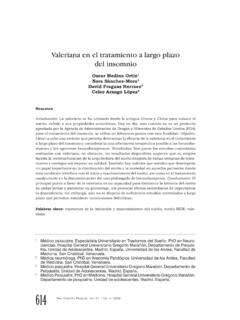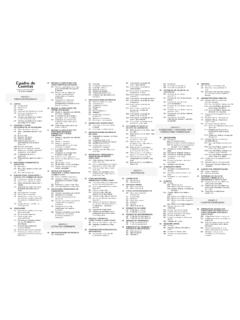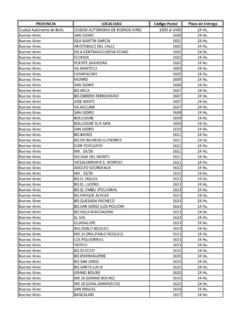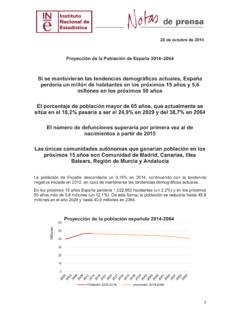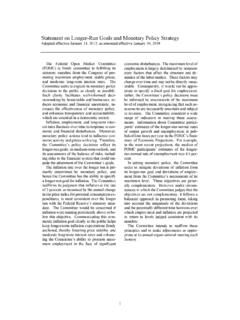Transcription of LONG - Sepp Hochreiter
1 long SHORT-TERM MEMORY. Neural Computation 9(8):1735{1780, 1997. Sepp Hochreiter J urgen Schmidhuber Fakult at f ur Informatik IDSIA. Technische Universit at M unchen Corso Elvezia 36. 80290 M unchen, Germany 6900 Lugano, Switzerland ~hochreit ~juergen Abstract Learning to store information over extended time intervals via recurrent backpropagation takes a very long time, mostly due to insu cient, decaying error back ow. We brie y review Hochreiter 's 1991 analysis of this problem, then address it by introducing a novel, e cient, gradient-based method called \ long Short-Term Memory" (LSTM). Truncating the gradient where this does not do harm, LSTM can learn to bridge minimal time lags in excess of 1000.}
2 Discrete time steps by enforcing constant error ow through \constant error carrousels" within special units. Multiplicative gate units learn to open and close access to the constant error ow. LSTM is local in space and time; its computational complexity per time step and weight is O(1). Our experiments with arti cial data involve local, distributed, real-valued, and noisy pattern representations. In comparisons with RTRL, BPTT, Recurrent Cascade-Correlation, Elman nets, and Neural Sequence Chunking, LSTM leads to many more successful runs, and learns much faster. LSTM also solves complex, arti cial long time lag tasks that have never been solved by previous recurrent network algorithms.
3 1 INTRODUCTION. Recurrent networks can in principle use their feedback connections to store representations of recent input events in form of activations (\short-term memory", as opposed to \ long -term mem- ory" embodied by slowly changing weights). This is potentially signi cant for many applications, including speech processing, non-Markovian control, and music composition ( , Mozer 1992). The most widely used algorithms for learning what to put in short-term memory, however, take too much time or do not work well at all, especially when minimal time lags between inputs and corresponding teacher signals are long . Although theoretically fascinating, existing methods do not provide clear practical advantages over, say, backprop in feedforward nets with limited time windows.
4 This paper will review an analysis of the problem and suggest a remedy. The problem. With conventional \Back-Propagation Through Time" (BPTT, , Williams and Zipser 1992, Werbos 1988) or \Real-Time Recurrent Learning" (RTRL, , Robinson and Fallside 1987), error signals \ owing backwards in time" tend to either (1) blow up or (2) vanish: the temporal evolution of the backpropagated error exponentially depends on the size of the weights ( Hochreiter 1991). Case (1) may lead to oscillating weights, while in case (2) learning to bridge long time lags takes a prohibitive amount of time, or does not work at all (see section 3). The remedy.
5 This paper presents \ long Short-Term Memory" (LSTM), a novel recurrent network architecture in conjunction with an appropriate gradient-based learning algorithm. LSTM. is designed to overcome these error back- ow problems. It can learn to bridge time intervals in excess of 1000 steps even in case of noisy, incompressible input sequences, without loss of short time lag capabilities. This is achieved by an e cient, gradient-based algorithm for an architecture 1. enforcing constant (thus neither exploding nor vanishing) error ow through internal states of special units (provided the gradient computation is truncated at certain architecture-speci c points | this does not a ect long -term error ow though).
6 Outline of paper. Section 2 will brie y review previous work. Section 3 begins with an outline of the detailed analysis of vanishing errors due to Hochreiter (1991). It will then introduce a naive approach to constant error backprop for didactic purposes, and highlight its problems concerning information storage and retrieval. These problems will lead to the LSTM architecture as described in Section 4. Section 5 will present numerous experiments and comparisons with competing methods. LSTM outperforms them, and also learns to solve complex, arti cial tasks no other recurrent net algorithm has solved. Section 6 will discuss LSTM's limitations and advantages.
7 The appendix contains a detailed description of the algorithm ( ), and explicit error ow formulae ( ). 2 PREVIOUS WORK. This section will focus on recurrent nets with time-varying inputs (as opposed to nets with sta- tionary inputs and xpoint-based gradient calculations, , Almeida 1987, Pineda 1987). Gradient-descent variants. The approaches of Elman (1988), Fahlman (1991), Williams (1989), Schmidhuber (1992a), Pearlmutter (1989), and many of the related algorithms in Pearl- mutter's comprehensive overview (1995) su er from the same problems as BPTT and RTRL (see Sections 1 and 3). Time-delays. Other methods that seem practical for short time lags only are Time-Delay Neural Networks (Lang et al.)
8 1990) and Plate's method (Plate 1993), which updates unit activa- tions based on a weighted sum of old activations (see also de Vries and Principe 1991). Lin et al. (1995) propose variants of time-delay networks called NARX networks. Time constants. To deal with long time lags, Mozer (1992) uses time constants in uencing changes of unit activations (deVries and Principe's above-mentioned approach (1991) may in fact be viewed as a mixture of TDNN and time constants). For long time lags, however, the time constants need external ne tuning (Mozer 1992). Sun et al.'s alternative approach (1993) updates the activation of a recurrent unit by adding the old activation and the (scaled) current net input.
9 The net input, however, tends to perturb the stored information, which makes long -term storage impractical. Ring's approach. Ring (1993) also proposed a method for bridging long time lags. Whenever a unit in his network receives con icting error signals, he adds a higher order unit in uencing appropriate connections. Although his approach can sometimes be extremely fast, to bridge a time lag involving 100 steps may require the addition of 100 units. Also, Ring's net does not generalize to unseen lag durations. Bengio et al.'s approaches. Bengio et al. (1994) investigate methods such as simulated annealing, multi-grid random search, time-weighted pseudo-Newton optimization, and discrete error propagation.
10 Their \latch" and \2-sequence" problems are very similar to problem 3a with minimal time lag 100 (see Experiment 3). Bengio and Frasconi (1994) also propose an EM approach for propagating targets. With n so-called \state networks", at a given time, their system can be in one of only n di erent states. See also beginning of Section 5. But to solve continuous problems such as the \adding problem" (Section ), their system would require an unacceptable number of states ( , state networks). Kalman lters. Puskorius and Feldkamp (1994) use Kalman lter techniques to improve recurrent net performance. Since they use \a derivative discount factor imposed to decay expo- nentially the e ects of past dynamic derivatives," there is no reason to believe that their Kalman Filter Trained Recurrent Networks will be useful for very long minimal time lags.

